Zachary Crockett reports in Price Economics:
30% of all photographs taken by 18 to 24 year-olds are selfies. Men who frequently post selfies score significantly higher in the traits of “narcissism” and “psychopathy” in personality tests. As a result, when these men take a selfie, they brush off potential dangers in favor of validation and personal gain.
The selfie is inescapable.Though in its waning days as a buzzword, it continues to pervade every facet of daily life. In the course of any given week, “selfie” is mentioned in 365,000 Facebook posts and 150,000 tweets. A comb of Instagram hashtags turns up more than 50 million results for the word.Like any wide-spread activity, the selfie is not immune to tragedy. In pursuit of the ultimate profile pic, stick-yielding youths often go to extremes: They perch themselves on cliffs. They pose beside wild animals. They play chicken with oncoming trains. And sometimes, they don’t make it out alive.While selfie deaths have received a fair amount of coverage (last year’s viral post about how more people die from selfies than shark attacks comes to mind), the extent of the problem, and the data behind it, hasn’t been appropriately explored.So, we went through three years of news archives, compiling every reported instance of a selfie-related death (that is, a death that was precipitated by taking a selfie). This is by no means a conclusive study (there are, no doubt, unreported cases), but it still gives us a visage into both the scope of the issue, and those who are affected by it. Here’s what we found: since 2014, 49 people have died while attempting to photograph themselves; the average age of the victims is 21 years old, and 75% of them are male.Zachary Crockett; Data via Google News Archives, Wikipedia. NOTE: 4 fatalities are not represented in the top chart, as the age was undeterminedPolls have shown that 30% of all photographs taken by 18 to 24 year-olds are selfies — the highest percentage of any age bracket. So the average age here (21) doesn’t come as much of a surprise: it makes sense that the demographic taking the most selfies also perishes the most in the process.Though women take significantly more selfies than men, 36 of the 49 selfie-related fatality victims were male. Studies have proven that men are two times more likely to take recreational risks than women are, even when it comes to selfies. Researchers at Ohio State University found that men who frequently post selfies score significantly higher in the traits of “narcissism” and “psychopathy” in personality tests. As a result, when these men take a selfie, they brush off potential dangers in favor of validation and personal gain."It's all about me. It's putting me in the frame. I'm getting attention and when I post that to social media, I'm getting the confirmation that I need from other people that I'm awesome," says lead researcher Jesse Fox. "You're not thinking about the consequences of your actions, so who cares if you're dangling off the side of the Eiffel Tower?"Next, let's take a look at the fatal risks selfie-enthusiasts are taking.Zachary Crockett; Data via Google News Archives, WikipediaOne-third of all people who met their demise in the midst of a selfie fell from heights — most commonly, a cliff or a building.In late August of 2015, for example, a 25 year-old man Chinese man ventured off-trail to snap a selfie at the top of Long Men waterfall in eastern China. Distracted by the camera, he took a misstep and plunged 100 feet down into a ravine, where he died instantly. When authorities recovered his body several days later, his selfie stick-mounted phone — still intact — contained a picture of him in the process of falling.The following month, a 17 year-old Russian student climbed a nine-story building near Moscow, and hung off the ledge to make it appear as if he were falling. He intended to capture the “ultimate” selfie for his Instagram page; instead, his hand slipped, and he fell to his death. Just weeks earlier, he’d posted a similar image of himself in a precarious position:Via Instagram (Drewssik)Such stunts are not gender-exclusive: earlier this month, a 19 year-old girl stumbled off of a 20-story building in the Philippines while taking a selfie; she died on impact. "She was not satisfied with the photos we had taken [of her],” her classmate later told a local paper, “so she decided to climb up and take her own."Sadly, selfie-takers get much more extreme than cliffs and buildings. Eight victims have been been killed by trains — either via electrocution or direct impact.In march of 2014, a young man posed for a selfie atop a boxcar. Diverted, he was unaware of the 35,000-volt livewire just beside him. When he stepped on it, he was instantly killed. Weeks later, a nearly identical incident occurred in Kerala, India.Three 20-year-old college students were killed last January after attempting to “play daredevil” with on oncoming train in India. According to a friend who bailed out at the last minute, the men were hoping to capture a selfie that would get them “many likes” on social networking sites.Then there are the truly bizarre cases: The 21-year-old Mexican man who accidentally shot himself in the head while taking a selfie with a gun. The Cessna pilot who crashed, killing both himself and a passenger, after his cellphone selfies led him to lose control of the aircraft. The two Russian teens who blew themselves up while posing for a selfie with a live grenade in the Ural Mountains. The man who attempted a selfie at the running of the bulls festival in Spain and was fatally gored in the neck.It seems that humans from all corners of the Earth are prone to taking selfies at sub-optimal moments. Where do the worst case outcomes most commonly happen?Zachary Crockett; Data via Google News Archives, WikipediaTo an alarming degree, selfie deaths seem to plague India. Here, 19 individuals — 40% of all selfie-related fatalities — met their demise. This can’t solely be attributed to India’s large population (China, by contrast, has only one reported death). So what’s going on?In general, India has a very high drowning fatality rate. Each year, 86,000 people drown in the country, roughly 20% of all drowning deaths worldwide. According to the United Nations’ World Health Organization, the bulk of these deaths are youths between the ages of 15 and 25, many of whom never had the resources to properly learn how to swim — especially in India’s poorly-equipped waterways.“The rains fill ditches and cause rivers and lakes to swell throughout the country, creating hazards for locals,” one public official told the International Business Times. “Villagers are often too preoccupied with their work to adequately supervise their [children’s] play. When a child is pulled from the water, most villagers lack any knowledge of proper resuscitation techniques.”Add to this mix a distracted selfie-taker, and you have a recipe for disaster.The stories are bountiful, and tragic, and often involve large groups of teenagers. In March of 2015, for instance, seven boys drowned on a lake in Nagpur, India after standing up for a selfie and flipping their boat. Four more drowned in the Narmada Canal (a 332-mile waterway that is prone to flooding) after slipping off the banks during a selfie, and two more were swept away by the current at a beach in Mumbai.In the wake of these tragedies, government officials in India have declared 16 “no selfie zones” throughout the country, where large signs and lifeguards warn selfie-takers to steer clear.India isn’t the first country to do this: Russia — which ranks second, with 7 selfie fatalities — released a full-scale marketing campaign last summer (complete with icons of bad selfie ideas) aimed at reducing the spat of deaths in their country."When a person is trying to take a picture of themselves, they become distracted, lose their balance, they don't look around and don't feel in danger," reads a website set up for the cause. "When taking a selfie, be sure that you are in a safe place and your life is not in danger!"This leads us to a final question: are selfies risky by nature, or is the only dangerous component the underlying behavior that accompanies them?Of the 49 cases we examined, not a single death was caused by the selfie itself. To our knowledge, nobody has ever been fatally impaled by a selfie stick; rather, the selfie seems to serve as an inopportune catalyst — a distractor in situations where the picture-taker should should be focused on safety.“A lot of these so-called selfie deaths can be blamed more on carelessness than photography,” Morgan O’Rourke, a risk management professional with 15 years of experience, tells us. “You have to be careful about taking shortcuts when trying to determine what is and isn’t threatening.”Data via Google News Archives, CDC reports, academic studies; when a 2015 figure was not available, an estimate was made based off of historical data.Still, most extreme selfie-takers are driven by the validation of their peers on social media. A look through the Instagram page of Andrey Retrovsky — the 17-year-old who died taking a selfie on a 9-story building in Russian — yields words of encouragement from users: “Keep getting crazier, bro!”; “Next, try a skyscraper”; “If you [climb] higher, it will be sexier ;)”.Many of those who died taking selfies seem to have fallen victim to the Internet’s show-all, tell-all daredevil mentality. As one professional photographer imparts to his admirers in a blog post: “The best photos happen only when you take risks to get them; you have to be willing to lose in order to win big.”Some losses just don’t seem worth it.


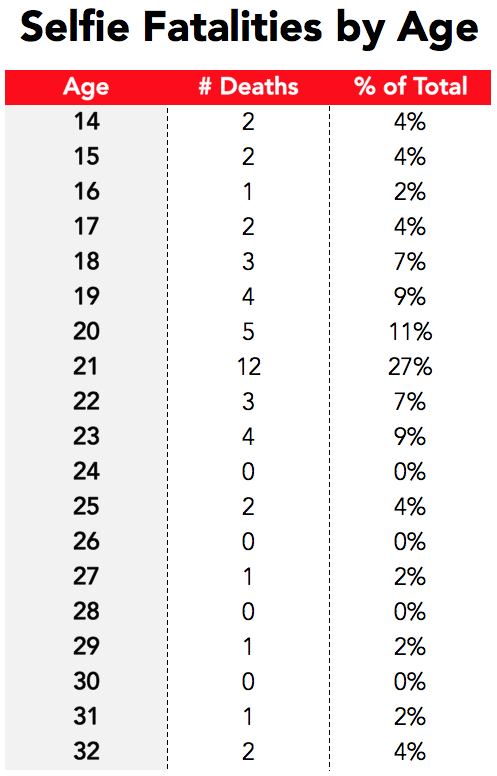
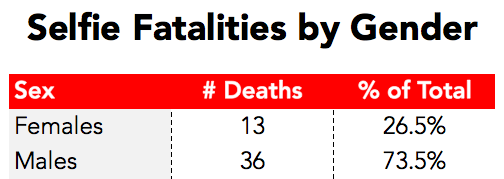
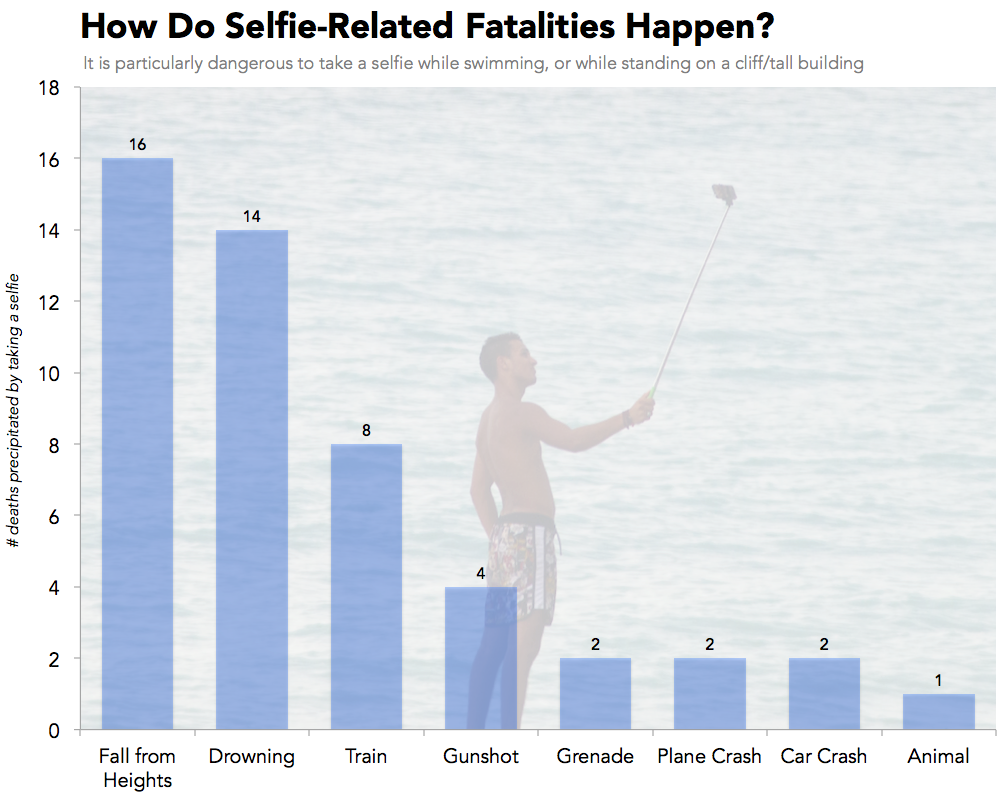
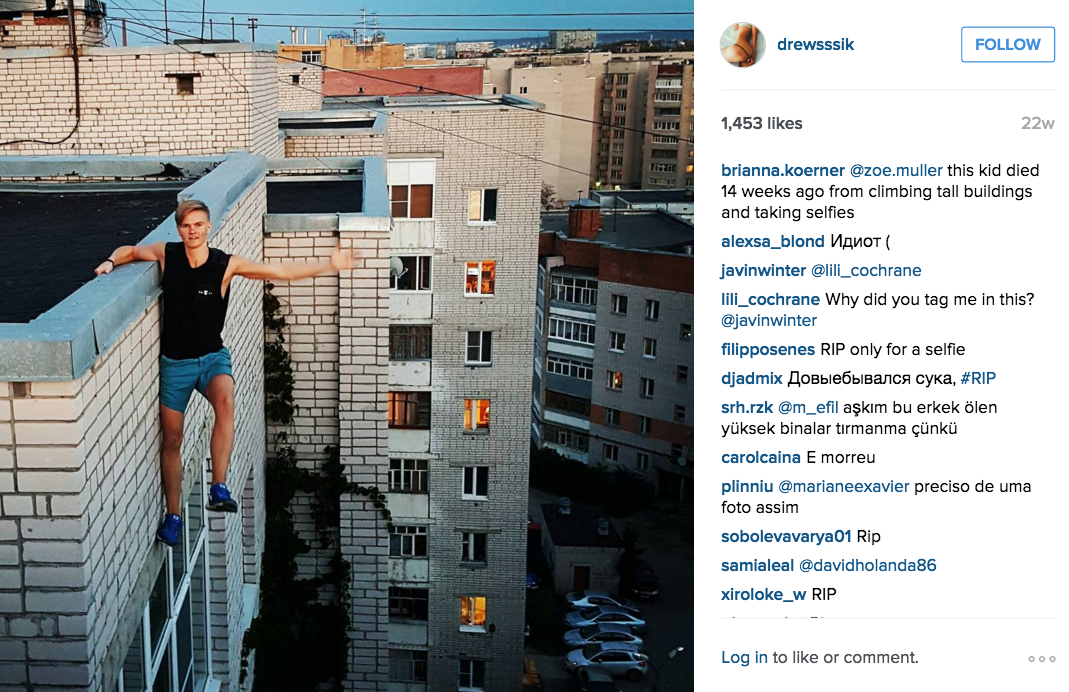


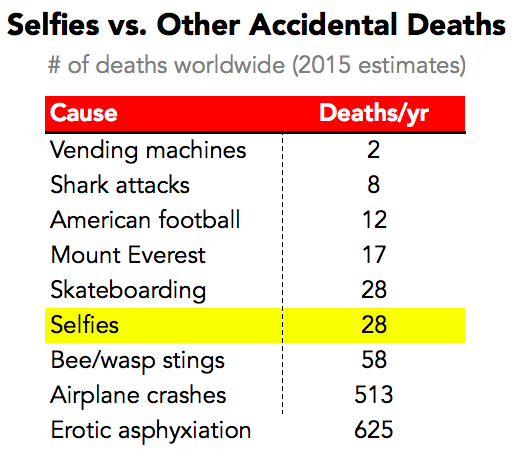


















1 comments:
Very interesting, Wish to see much more like this. Thanks for sharing your information. We are providing selfie flash light for all mobiles just visit our website.
Post a Comment